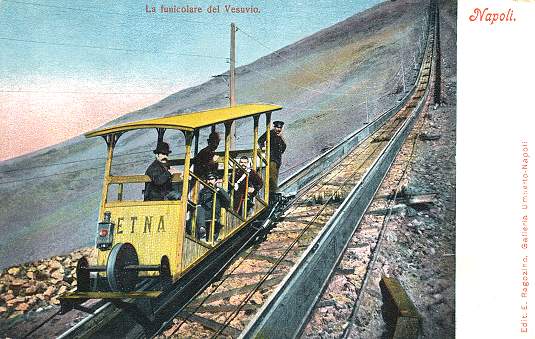

Our postcard shows 'Etna', one of the two cars built in 1889 to run on the monorail funicular railway on Mount Vesuvius. It was published around 1902 by E.Ragozino of Galeria Umberto in Naples. The small coloured view below is of sister car 'Versuvio' taken from another postcard by the same publisher. The other small views are from postcards and photographs from unknown publishers.
Rising to 1281 metres (current height, it varies after eruptions) and overlooking the Bay of Naples in Italy, Mount Vesuvius is one of the world's most famous volcanoes and is the only active volcano on mainland Europe. The eruption of 79 A.D. buried the Roman towns of Pompeii and Herculaneum (modern day Ercolano) leaving us with a remarkable archaeological heritage. In Victorian times a visit was a must for those doing the 'Grand Tour' such as was organized by travel agents Thomas Cook & Son.
In the late 1870s Hungarian Ernesto Emmanuele Oblieght promoted the idea of a funicular railway on the slopes of the mountain, with a study by engineers Galanti, Sigl and Wolfart, and with the backing of the Banco di Roma gave a contract to Emilio Olivieri of Milan to build it. The local community was to be paid an annual fee plus a tax on every passenger. The line opened to the public on 6th June 1880. In 1886 operation of the line was ceded to a French company, Société Anonyme du Chemin de Fer Funicolaire du Vésuve. A round trip with guides from Naples to the summit by horse carriage and funicular cost about a pound, a high figure for the time, but despite good trade the running costs and concession fees were too high and by the 1887 season the line seemed likely to close. John Mason Cook (son of Thomas Cook) initially provided money to keep the system going to carry his tourists, and in 1888 bought the funicular concession outright.
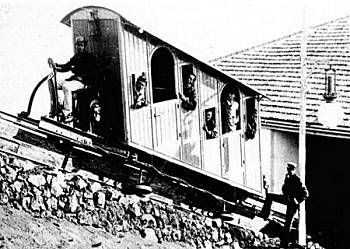 Technically the funicular consisted of two separate tracks, one for each of the two counterbalanced cars (left), which seated 8 and were named 'Etna' and 'Vesuvio'. The route was 806 metres long and climbed 391 metres at a maximum gradient of 63%. There was a longitudinal wooden sleeper on the top of which was carried a single rail. The cars had a double flanged wheel at each end which ran on this rail. In addition there were two angled rails, one fixed to each side of the sleeper at its base. The cars had wheels mounted from their floors which engaged on these side rails and kept the cars upright. Each track had two continuous cables carried on pulleys which were fixed to each side of the car. These cables were 22mm diameter steel ropes with a hempen core and with six strands each consisting of eight steel wires. The winding house was at the bottom, where there were two 45 horsepower high pressure steam engines (one a reserve) and coal fired boilers. The winding drum had automatic brakes to control the speed and the cars also had automatic brakes applied if the cable went slack. As coal had to be brought up the mountain on horseback, this became an expensive item.
Technically the funicular consisted of two separate tracks, one for each of the two counterbalanced cars (left), which seated 8 and were named 'Etna' and 'Vesuvio'. The route was 806 metres long and climbed 391 metres at a maximum gradient of 63%. There was a longitudinal wooden sleeper on the top of which was carried a single rail. The cars had a double flanged wheel at each end which ran on this rail. In addition there were two angled rails, one fixed to each side of the sleeper at its base. The cars had wheels mounted from their floors which engaged on these side rails and kept the cars upright. Each track had two continuous cables carried on pulleys which were fixed to each side of the car. These cables were 22mm diameter steel ropes with a hempen core and with six strands each consisting of eight steel wires. The winding house was at the bottom, where there were two 45 horsepower high pressure steam engines (one a reserve) and coal fired boilers. The winding drum had automatic brakes to control the speed and the cars also had automatic brakes applied if the cable went slack. As coal had to be brought up the mountain on horseback, this became an expensive item.
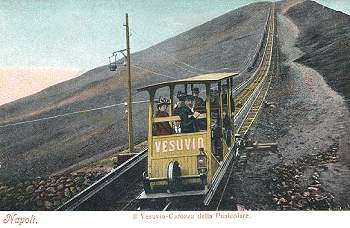 Cook's new venture did not go smoothly. There were disputes over the high fees paid to the local guides, who then damaged the system destroying one of the carriages and forcing a six month closure. Cook set about renovating it with new winding gear and cables and with two new cars which seated 10, also called 'Etna' and 'Vesuvio' (right). Full service on the renovated line began in May 1889, keeping the existing Swiss manager, Enrico Treiber, and with Thomas Cook & Son as agents. An early visitor was the Prince of Naples and the line inspired the popular song 'Funiculi - Funicula', written by Peppino Turco and set to music by Luigi Denza in 1880.
Cook's new venture did not go smoothly. There were disputes over the high fees paid to the local guides, who then damaged the system destroying one of the carriages and forcing a six month closure. Cook set about renovating it with new winding gear and cables and with two new cars which seated 10, also called 'Etna' and 'Vesuvio' (right). Full service on the renovated line began in May 1889, keeping the existing Swiss manager, Enrico Treiber, and with Thomas Cook & Son as agents. An early visitor was the Prince of Naples and the line inspired the popular song 'Funiculi - Funicula', written by Peppino Turco and set to music by Luigi Denza in 1880.
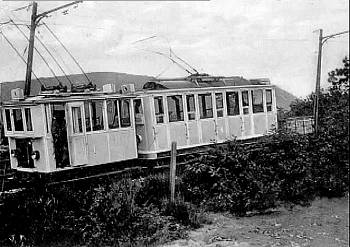 To boost trade John Cook thought a railway from Naples to serve the funicular was needed. A survey and proposal from George Noble Fell (of the Manx Snaefell Mountain Railway fame) for a standard gauge steam railway using the Abt rack system proved too costly, but a counter proposal from the Swiss companies Schweizerische Locomotiv und Maschinenfabrik (SLM) and Brown, Boveri for a shorter metre gauge electric railway were taken up and the new line was opened on 28th September 1903 (left), although by then John Cook had died and the funicular and new railway passed into the ownership of Thomas Cook & Son. This new railway ran 7.7 km, over three sections, from close to the station of the 950mm gauge Circumvesuviana railway at Pugliano, where visitors arrived from Naples, to the funicular base station. Three light blue and cream 24 seat tram-like cars (later four) from Schweizerische Waggons und Aufzuegefabrik AG carried the passengers throughout their journey, but were assisted on the centre section by being pushed by two (later three) Strub rack railway locomotives from SLM. Power was 550 volt DC generated by Brown, Boveri gas engines and dynamos.
To boost trade John Cook thought a railway from Naples to serve the funicular was needed. A survey and proposal from George Noble Fell (of the Manx Snaefell Mountain Railway fame) for a standard gauge steam railway using the Abt rack system proved too costly, but a counter proposal from the Swiss companies Schweizerische Locomotiv und Maschinenfabrik (SLM) and Brown, Boveri for a shorter metre gauge electric railway were taken up and the new line was opened on 28th September 1903 (left), although by then John Cook had died and the funicular and new railway passed into the ownership of Thomas Cook & Son. This new railway ran 7.7 km, over three sections, from close to the station of the 950mm gauge Circumvesuviana railway at Pugliano, where visitors arrived from Naples, to the funicular base station. Three light blue and cream 24 seat tram-like cars (later four) from Schweizerische Waggons und Aufzuegefabrik AG carried the passengers throughout their journey, but were assisted on the centre section by being pushed by two (later three) Strub rack railway locomotives from SLM. Power was 550 volt DC generated by Brown, Boveri gas engines and dynamos.
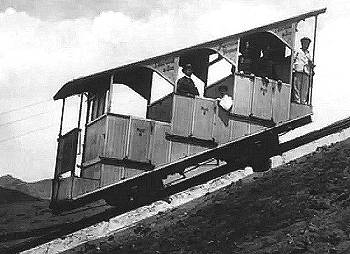 This new electric railway brought about the end of the funicular monorail, as this elderly system was overwhelmed by the increase in traffic. A new metre gauge funicular with normal single track and a central passing loop was built and opened in 1904 (right), with an electric winding house taking power from the railway. The new cars seated 18 with 6 standing. To cater for this expanded trade Thomas Cook also had a hotel called the Hermitage built at Eremo, about half way along the electric railway's route. All this was not to last long. On 7th April 1906 a huge eruption wiped out the top of the funicular and its cars and buried everything else in volcanic ash. Although the railway as far as the hotel was quickly dug out, the funicular had to wait.
This new electric railway brought about the end of the funicular monorail, as this elderly system was overwhelmed by the increase in traffic. A new metre gauge funicular with normal single track and a central passing loop was built and opened in 1904 (right), with an electric winding house taking power from the railway. The new cars seated 18 with 6 standing. To cater for this expanded trade Thomas Cook also had a hotel called the Hermitage built at Eremo, about half way along the electric railway's route. All this was not to last long. On 7th April 1906 a huge eruption wiped out the top of the funicular and its cars and buried everything else in volcanic ash. Although the railway as far as the hotel was quickly dug out, the funicular had to wait.
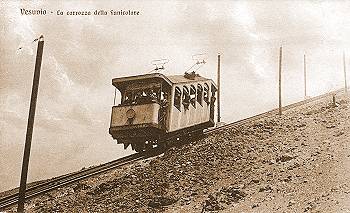 In fact it was not until 1909 that the funicular was rebuilt and it reopened in 1910 with two new 5-bay end loading cars (left), numbered 1 and 2, which seated 16 with 8 standing. The line now had overhead wire and the cars bow collectors, not for traction purposes but to provide electric light and which was also used for bell signals and a telephone. The funicular could now run an after dark service. A 1911 eruption destroyed the funicular upper station building which had once again to be rebuilt. All went fairly well for many years with no damage in the 1929 eruption, and with three larger cars being acquired for the electric railway in the 1920s, but by the 30s the line was losing money and because of nationalism in Italy the system was passed to a locally registered company, Società Anonima Italiana per le Ferrovie del Vesuvio, which was a Thomas Cook subsidiary.
In fact it was not until 1909 that the funicular was rebuilt and it reopened in 1910 with two new 5-bay end loading cars (left), numbered 1 and 2, which seated 16 with 8 standing. The line now had overhead wire and the cars bow collectors, not for traction purposes but to provide electric light and which was also used for bell signals and a telephone. The funicular could now run an after dark service. A 1911 eruption destroyed the funicular upper station building which had once again to be rebuilt. All went fairly well for many years with no damage in the 1929 eruption, and with three larger cars being acquired for the electric railway in the 1920s, but by the 30s the line was losing money and because of nationalism in Italy the system was passed to a locally registered company, Società Anonima Italiana per le Ferrovie del Vesuvio, which was a Thomas Cook subsidiary.
The lines ran during the Second World War but in March 1944 Vesuvius erupted again, once more destroying the funicular. The electric railway reopened but with low income prospects Thomas Cook could not rebuild the funicular and sold the railway to the operators of the Circumvesuviana railway. In 1953 a chair lift was installed by Von Roll to serve the summit. At this time the electric railway was still running, but soon partly closed as an improved road was built to Eremo, and at the end of 1955 it completely closed. The chair lift operated until 1984. Today a visitor must take a bus from Ercolano (or drive by car) to the former funicular base station and then walk to the summit.
![]() Go to Postcard Of The Month Index
Go to Postcard Of The Month Index